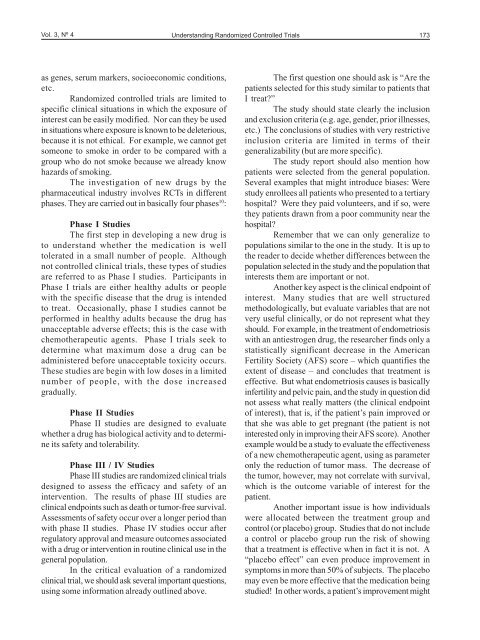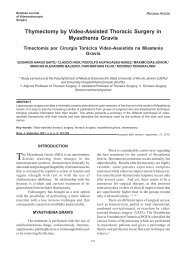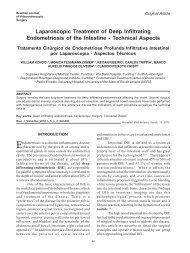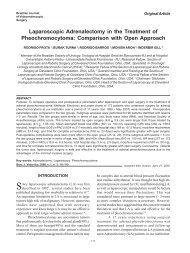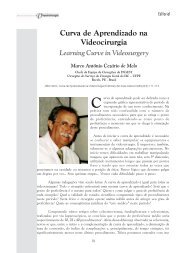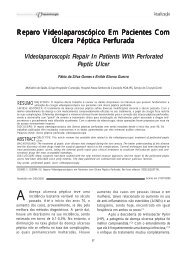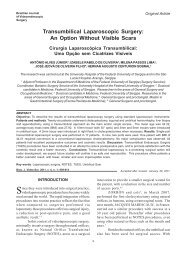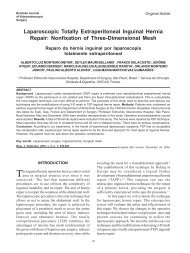Understanding Randomized Controlled Trials - Sobracil
Understanding Randomized Controlled Trials - Sobracil
Understanding Randomized Controlled Trials - Sobracil
Create successful ePaper yourself
Turn your PDF publications into a flip-book with our unique Google optimized e-Paper software.
Vol. 3, Nº 4<br />
<strong>Understanding</strong> <strong>Randomized</strong> <strong>Controlled</strong> <strong>Trials</strong> 173<br />
as genes, serum markers, socioeconomic conditions,<br />
etc.<br />
<strong>Randomized</strong> controlled trials are limited to<br />
specific clinical situations in which the exposure of<br />
interest can be easily modified. Nor can they be used<br />
in situations where exposure is known to be deleterious,<br />
because it is not ethical. For example, we cannot get<br />
someone to smoke in order to be compared with a<br />
group who do not smoke because we already know<br />
hazards of smoking.<br />
The investigation of new drugs by the<br />
pharmaceutical industry involves RCTs in different<br />
phases. They are carried out in basically four phases 10 :<br />
Phase I Studies<br />
The first step in developing a new drug is<br />
to understand whether the medication is well<br />
tolerated in a small number of people. Although<br />
not controlled clinical trials, these types of studies<br />
are referred to as Phase I studies. Participants in<br />
Phase I trials are either healthy adults or people<br />
with the specific disease that the drug is intended<br />
to treat. Occasionally, phase I studies cannot be<br />
performed in healthy adults because the drug has<br />
unacceptable adverse effects; this is the case with<br />
chemotherapeutic agents. Phase I trials seek to<br />
determine what maximum dose a drug can be<br />
administered before unacceptable toxicity occurs.<br />
These studies are begin with low doses in a limited<br />
number of people, with the dose increased<br />
gradually.<br />
Phase II Studies<br />
Phase II studies are designed to evaluate<br />
whether a drug has biological activity and to determine<br />
its safety and tolerability.<br />
Phase III / IV Studies<br />
Phase III studies are randomized clinical trials<br />
designed to assess the efficacy and safety of an<br />
intervention. The results of phase III studies are<br />
clinical endpoints such as death or tumor-free survival.<br />
Assessments of safety occur over a longer period than<br />
with phase II studies. Phase IV studies occur after<br />
regulatory approval and measure outcomes associated<br />
with a drug or intervention in routine clinical use in the<br />
general population.<br />
In the critical evaluation of a randomized<br />
clinical trial, we should ask several important questions,<br />
using some information already outlined above.<br />
The first question one should ask is “Are the<br />
patients selected for this study similar to patients that<br />
I treat?”<br />
The study should state clearly the inclusion<br />
and exclusion criteria (e.g. age, gender, prior illnesses,<br />
etc.) The conclusions of studies with very restrictive<br />
inclusion criteria are limited in terms of their<br />
generalizability (but are more specific).<br />
The study report should also mention how<br />
patients were selected from the general population.<br />
Several examples that might introduce biases: Were<br />
study enrollees all patients who presented to a tertiary<br />
hospital? Were they paid volunteers, and if so, were<br />
they patients drawn from a poor community near the<br />
hospital?<br />
Remember that we can only generalize to<br />
populations similar to the one in the study. It is up to<br />
the reader to decide whether differences between the<br />
population selected in the study and the population that<br />
interests them are important or not.<br />
Another key aspect is the clinical endpoint of<br />
interest. Many studies that are well structured<br />
methodologically, but evaluate variables that are not<br />
very useful clinically, or do not represent what they<br />
should. For example, in the treatment of endometriosis<br />
with an antiestrogen drug, the researcher finds only a<br />
statistically significant decrease in the American<br />
Fertility Society (AFS) score – which quantifies the<br />
extent of disease – and concludes that treatment is<br />
effective. But what endometriosis causes is basically<br />
infertility and pelvic pain, and the study in question did<br />
not assess what really matters (the clinical endpoint<br />
of interest), that is, if the patient’s pain improved or<br />
that she was able to get pregnant (the patient is not<br />
interested only in improving their AFS score). Another<br />
example would be a study to evaluate the effectiveness<br />
of a new chemotherapeutic agent, using as parameter<br />
only the reduction of tumor mass. The decrease of<br />
the tumor, however, may not correlate with survival,<br />
which is the outcome variable of interest for the<br />
patient.<br />
Another important issue is how individuals<br />
were allocated between the treatment group and<br />
control (or placebo) group. Studies that do not include<br />
a control or placebo group run the risk of showing<br />
that a treatment is effective when in fact it is not. A<br />
“placebo effect” can even produce improvement in<br />
symptoms in more than 50% of subjects. The placebo<br />
may even be more effective that the medication being<br />
studied! In other words, a patient’s improvement might


